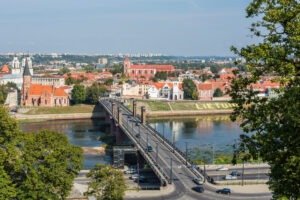St. Paul’s Cathedral

St. Paul’s Cathedral is one of the most iconic landmarks in London. Located in the heart of the city, the cathedral is a testament to the city’s rich history and architectural heritage. It is a must-visit destination for anyone visiting London. In this travel guide, we will explore the history and significance of St. Paul’s Cathedral and provide tips for visiting this historic landmark.
History and Significance
St. Paul’s Cathedral was designed by Sir Christopher Wren, an architect who lived in the 17th century. The cathedral was built to replace the old St. Paul’s Cathedral, which was destroyed in the Great Fire of London in 1666. The construction of the cathedral began in 1675 and was completed in 1710. The cathedral is an example of Baroque architecture, which was popular in Europe during the 17th and 18th centuries.
St. Paul’s Cathedral has played an important role in the history of England. It has been the site of numerous significant events, including the funerals of Sir Winston Churchill and Margaret Thatcher. It was also the location of the wedding of Prince Charles and Lady Diana Spencer in 1981.
Visiting St. Paul’s Cathedral
Visiting St. Paul’s Cathedral is a must-do activity for anyone visiting London. The cathedral is open to visitors every day of the week except for Sundays, when it is only open for worship. Visitors can explore the cathedral’s impressive interior and climb to the top of the dome for breathtaking views of the city.
One of the most impressive features of St. Paul’s Cathedral is its dome. Visitors can climb to the top of the dome, which is over 365 feet high, and enjoy panoramic views of London. The climb to the top of the dome is not for the faint of heart, but it is definitely worth it for the stunning views.
Another highlight of a visit to St. Paul’s Cathedral is the Whispering Gallery. The Whispering Gallery is located inside the dome and is named for its unique acoustics. Visitors can whisper against the wall of the gallery and be heard on the other side of the dome, over 100 feet away.
Visitors can also explore the cathedral’s impressive interior. The cathedral is home to numerous works of art, including mosaics, sculptures, and stained glass windows. One of the most famous works of art in the cathedral is the painting “The Light of the World” by William Holman Hunt.
Tips for Visiting St. Paul’s Cathedral
If you are planning a visit to St. Paul’s Cathedral, there are a few things you should keep in mind. First, be sure to dress appropriately. The cathedral is a place of worship, and visitors are expected to dress modestly. Shorts and revealing clothing are not allowed.
Second, be prepared for a climb if you want to visit the top of the dome. The climb to the top of the dome is 528 steps and can be challenging for some visitors. If you have mobility issues or a fear of heights, it may be best to skip this part of the visit.
Finally, be sure to take advantage of the guided tours offered by the cathedral. The tours provide an in-depth look at the history and significance of the cathedral and can enhance your visit.
Conclusion
St. Paul’s Cathedral is a must-visit destination for anyone visiting London. Its impressive architecture, rich history, and stunning views make it a highlight of any trip to the city. Visitors can explore the cathedral’s impressive interior, climb to the top of the dome, and enjoy panoramic views of London. With a little preparation and planning, a visit to St. Paul’s Cathedral is sure to be an unforgettable experience.




